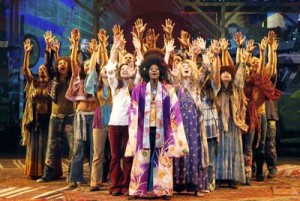Broadway stage brings hippies to life with Hair
One might think of hippies as symbols of the past and of the 1960s as the days when rebellious, fun-loving adolescents hooked up and sported loose-flowing natural-fiber shirts, unwashed long hair and peace signs.

Love is in the air · The musical goes beyond simply creating unity between fictional characters and reaches out to the audience, creating a participatory and interactive experience for the whole audience. - Photo courtesy of Broadway L.A.
Hair does little to dispel this stereotype.
Instead, it gleefully plays with this image, stretching it out with colorful, psychedelic abandonment. The musical’s energetic cast doesn’t just dance — it frolics, writhes, gropes, moons and grinds between woozy sessions of passing joints and chanting for freedom, peace and love.
Hair is a rock musical set in the 1960s during the Vietnam War and the hippie era. When it first opened on Broadway in 1968, it was met with controversy and mixed reviews, but became a huge financial success by 1970.
The show’s popularity spread from Finland to Japan to Israel and even the former Yugoslavia.
Under the direction of Diane Paulus, Hair was revived once again in 2007. It has been on a national tour since last October, presently shaking up the crowd at the Pantages Theater in Los Angeles. It’s a production you don’t want to miss.
The simplest, most superficial way to define Hair’s plot is a group of kids in 1960s New York gathering together as a tribe and reveling in self-proclaimed freedom from society’s rules and war’s brutality.
This philosophy is presented through its trademark opening song “Aquarius,” sung first in solo with dewy assurance from tribe member Dionne (Phyre Hawkins), and then echoed by the rest of the tribe in celebration of the “Age of Aquarius,” which they believe symbolizes a period of love, light and humanity.
But their battle hits too close to home when one of the main characters, Claude (Paris Remillard), gets a draft notice.
It then becomes clear that Hair is not just a story about a tribe of hippies protesting against the older generation’s social conventions and cruel war.
Much like their drug highs, the highs of idealism never lasts.
The tribe is mourning the evanescence of youth as they face imminent transition into the adult world of responsibilities and social law. They struggle with the timeless quest for self-identity in an ever-changing world.
In truth, they are just a bunch of scared, frightened kids trapped in a stifling world and complex time.
During the tribe’s “Be-In” movement, during which each member burns their draft card in protest, Claude agonizes, “Why do I live? Why do I die? Tell me, where do I go?” and finally refuses to burn his draft card.
It is one of Hair’s most touching scenes, and Remillard belts out his anguish with such soul and passion that the audience sits transfixed and aching with him.
Another notable character is Berger (Steel Burkhardt), who contrasts with Claude’s agonized position between the alternative hippie lifestyle and society’s broader expectations.
Berger is a flamboyant personification of hippie ideals. Perpetually stoned, he embraces his tribe’s beliefs with both grandness and goofiness. Those unknowing souls seated in the front row should prepare to be groped, mussed and flashed by Berger in a loincloth.
Remillard and Burkhardt’s portrayals of their characters are brilliant and endearing, but every other character deserves accolades as well, from the child-like, sex-crazed Woof (Matt DeAngelis) to the vulnerable, sensuous Sheila (Caren Lyn Tacket).
Because the show is all about freedom and individuality, it makes sense that the dancing appears free-flowing and spontaneous.
Choreographer Karole Armitage has done an impressive job on the choreography by injecting enough precision to give the tribe’s wiggles and twists a collective unity, while still infusing enough spirited idiosyncrasies to let each member retain their natural personality and warmth.
Each member is gifted with a powerful, soulful voice but their unique strength is the ability to bare all without a hint of self-consciousness.
One might imagine empathizing with what the characters believe, but the only people blushing during their bawdy gestures and scenes of nudity are the theater patrons themselves.
Paulus’ Hair production thrives on this organic, natural interaction with the audience.
From start to finish, the show leaps out from a contained stage performance to an exuberant invitation for everyone to let loose and celebrate all the good things left in life.
By the end of the show, you can’t help but want to jump up, shake and sing along, which is exactly what the audience did on Sunday night’s performance and is characteristic of virtually every performance.
After the bowing and standing ovation, performers, audience, lights and music meshed together into one jubilant party on the stage, hands held together, bodies swaying and singing the finale, “Let the Sunshine In,” together.
In one single moment, the age of the hippies is brought back to life.
